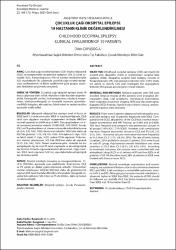| dc.contributor.author | Çavuşoğlu, Dilek | |
| dc.date.accessioned | 2022-04-29T12:28:54Z | |
| dc.date.available | 2022-04-29T12:28:54Z | |
| dc.date.issued | 2021 | en_US |
| dc.identifier.citation | Çavuşoğlu, D. (2021). CHILDHOOD OCCIPITAL EPILEPSY: Childhood occipital epilepsy: clinical evaluation of 19 patients. Kocatepe Tıp Dergisi , CİLT: 22 SAYI: 3 MAYIS 2021 ÖZEL SAYISI , 168-172 . DOI: 10.18229/kocatepetip.716277 | en_US |
| dc.identifier.issn | 2149-7869 | |
| dc.identifier.uri | https://doi.org/10.18229/kocatepetip.716277 | |
| dc.identifier.uri | https://hdl.handle.net/20.500.12933/882 | |
| dc.description.abstract | OBJECTIVE: Childhood occipital epilepsy (COE) can mainly be divided into idiopathic (IOLE) or symptomatic occipital lobe epilepsy (SOLE). Idiopathic occipital lobe epilepsy consists of Panayiotopoulos (PS) and Gastaut syndromes (GS). In this study, we aimed to classify COE and investigate the segregations between the groups according to clinical features.
MATERIAL AND METHODS: Nineteen patients with COE were enrolled. Medical records of the patients were evaluated. Demographic data, ictal symptoms, neurological examination, brain magnetic resonance imaging (MRI) and electroencephalography (EEG) findings, family history, febrile seizure, and treatment response were analyzed.
RESULTS: There were 6 patients diagnosed with idiopathic occipital lobe epilepsy and 13 patients diagnosed with SOLE. Compared to the SOLE, all patients of the IOLE had a normal neurological examination and MRI findings (p=0.044 and p=0.009). The most frequent ictal symptom was generalized seizures in all groups (100% IOLE, 75% SOLE). However, ictal vomiting was the most frequent autonomic seizure in IOLE and PS (2/6, 2/4; 33%, 50%). Nocturnal seizures were observed more frequently in IOLE than SOLE (1/13, 3/6; 8%, 50%). The rate of family history (1 patient, 25%) and febrile seizures (1 patient, 25%) were found in only PS group. Psychomotor/mental retardation was more common in SOLE than IOLE (8/13, 2/6; 62%, 33%). According to treatment outcomes, the seizures were controlled with one antiepileptic drug (AED) in all patients of PS and two AEDs in all patients of GS. On the other hand, 38% of patients in SOLE were treated with three or more AEDs.
CONCLUSIONS: Normal neurologic examination and neuroimaging are substantial features due to discrimination between IOLE and SOLE. Ictal vomiting is a remarkable autonomic seizure in IOLE and PS. Although psychomotor/mental retardation is observed higher in SOLE than IOLE, the patients of COE should be followed up carefully. IOLE has better treatment outcomes than SOLE and PS has better than GS. | en_US |
| dc.language.iso | eng | en_US |
| dc.publisher | Afyonkarahisar Sağlık Bilimleri Üniversitesi | en_US |
| dc.relation.isversionof | 10.18229/kocatepetip.716277 | en_US |
| dc.rights | info:eu-repo/semantics/openAccess | en_US |
| dc.subject | Occipital epilepsy | en_US |
| dc.subject | Child | en_US |
| dc.subject | Panayiotopoulos | en_US |
| dc.title | ÇOCUKLUK ÇAĞI OKSİPİTAL EPİLEPSİ:
19 HASTANIN KLİNİK DEĞERLENDİRİLMESİ | en_US |
| dc.title.alternative | CHILDHOOD OCCIPITAL EPILEPSY:
CLINICAL EVALUATION OF 19 PATIENTS | |
| dc.type | article | en_US |
| dc.authorid | 0000-0003-4924-5300 | en_US |
| dc.department | AFSÜ, Tıp Fakültesi, Dahili Tıp Bilimleri Bölümü, Çocuk Sağlığı ve Hastalıkları Ana Bilim Dalı | en_US |
| dc.contributor.institutionauthor | Çavuşoğlu, Dilek | |
| dc.identifier.volume | 22 | en_US |
| dc.identifier.issue | 3 | en_US |
| dc.identifier.startpage | 168 | en_US |
| dc.identifier.endpage | 172 | en_US |
| dc.relation.journal | Kocatepe Tıp Dergisi | en_US |
| dc.relation.publicationcategory | Makale - Ulusal Hakemli Dergi - Kurum Öğretim Elemanı | en_US |
















